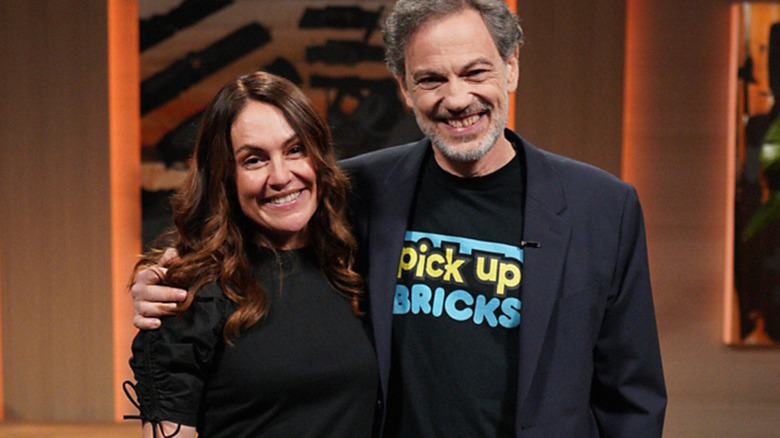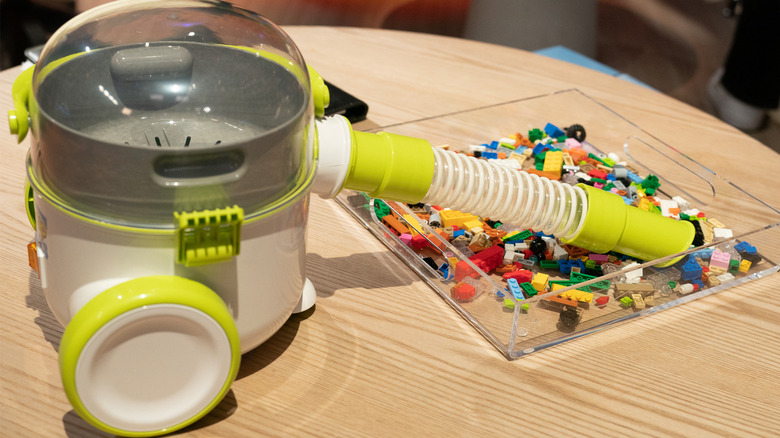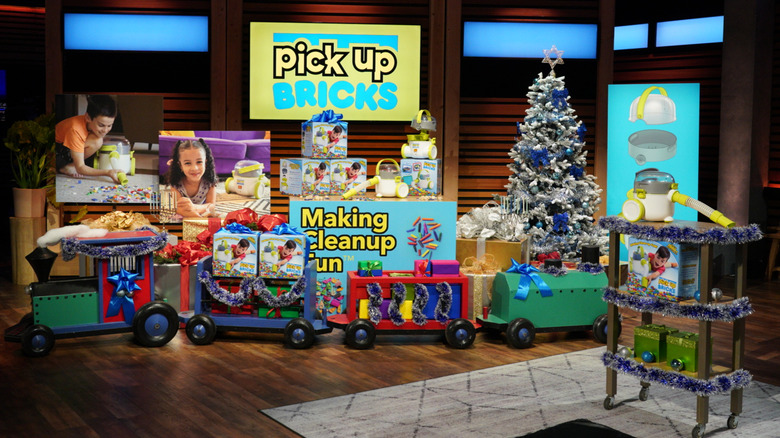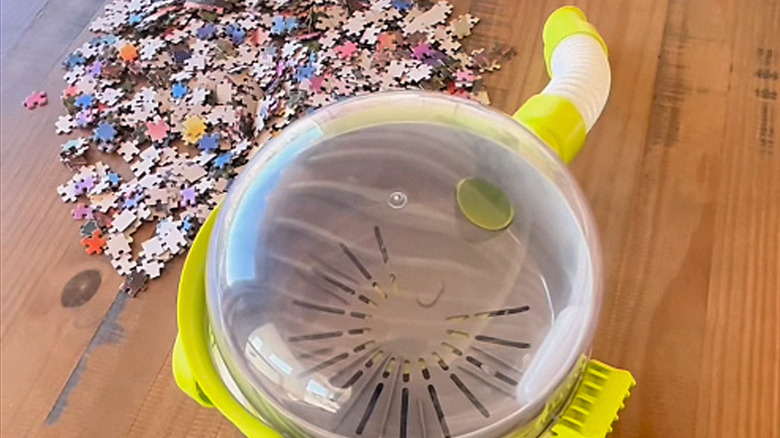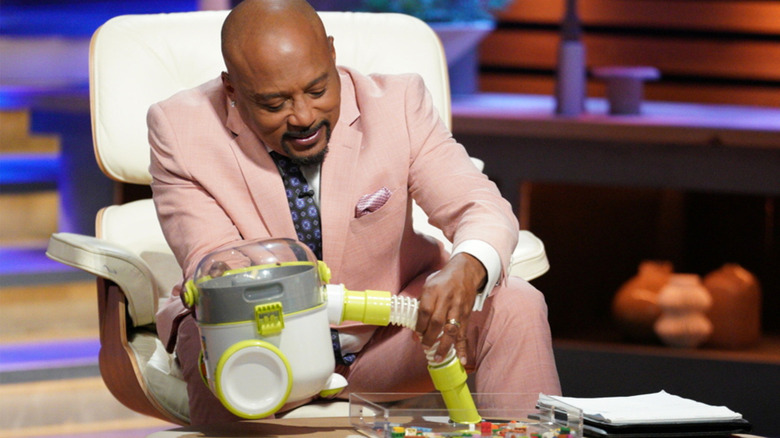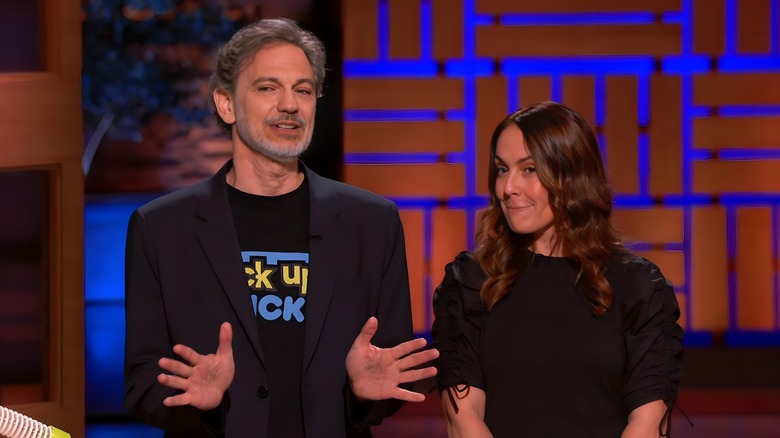What To Know About Shark Tank Product Pick Up Bricks
We may receive a commission on purchases made from links.
One of the businesses competing for the approval of the panel of Sharks on the December 8 episode of "Shark Tank" is called Pick-Up Bricks. Like plenty of its predecessors, including "Shark Tank" Season 13's Handy Pan, the business revolves around a single flagship offering. The core Pick-Up Bricks product is a vacuum designed for children, intended primarily to help and encourage children to clear the floor of Legos.
Unsurprisingly, company founders Aurora Weinstock and her brother-in-law, Steven Weinstock, came up with the idea for Pick-Up Bricks while thinking of how they could each get their own kids to pick up Legos and other small items after playtime. Of course, anyone and everyone with a history of Lego building is familiar with the acute pain of stepping on a Lego with a bare foot. Between its ease of use and toy-like appearance, Pick-Up Bricks isn't just a vacuum capable of being used by kids, but one that children will ideally look forward to incorporating into their Lego building sessions.
While Pick-Up Bricks is relatively new, the product has been receiving viral attention for its incorporation of some perhaps unexpected features. Here's everything "Shark Tank" viewers interested in the product need to know.
Pick-Up Bricks went viral on TikTok
Inevitably, interest in the Pick-Up Bricks will balloon in the immediate aftermath of owners Aurora and Steven Weinstock pitching their business on "Shark Tank." But even presuming this to be the case, this won't mark the first time the product will have earned some outsized attention after a media appearance. Rather than TV, however, the product's first brush with virality was thanks to a mommy blogger featuring the Pick-Up Bricks on her TikTok account.
In January, LaTreese Atkins shared a 14-second video — underscored by the Harry Styles single "As It Was" — showcasing the Pick-Up Bricks' basic functionality. Her account regularly shares so-called life hacks for mothers, and text on-screen describes the product as an "Amazon find." Presumably, then, Atkins genuinely spotted the product in an online search and, after buying one, decided it was useful enough to warrant sharing with her followers.
The video Atkins made ended up receiving more than 90,000 likes and generating more than 500 comments, doubtlessly putting the Pick-Up Bricks vacuum in front of more new eyeballs than traditional advertising ever could.
Before Shark Tank, the Pick-Up Bricks appeared on The Today Show
After LaTreese Atkins' TikTok video about the Pick-Up Bricks vacuum made its rounds online, a few different media outlets covered the video and its virality. Among these was the Today Show blog, which even interviewed Atkins about her association with the product.
Perhaps as a result of this piece, an episode of The Today Show that aired in March showcased a brief demonstration of the Pick-Up Bricks. At first, some of the Today panel seems skeptical of the product, but after witnessing its full functionality, the vacuum attracts the attention of two anchors who get out of their seats to get a closer look at it.
"Shark Tank," then, is not the first TV show to feature the Pick-Up Bricks. That said, it was solely the vacuum and not its founders that appeared on Today, so "Shark Tank" is nevertheless Aurora and Steven Weinstock's first time on network TV.
It's not just for Legos
Plenty of marketing for the Pick-Up Bricks — including LaTreese Atkins' viral TikTok video and its Today Show appearance — exclusively highlights the vacuum's ability to clean up Legos and Lego-like products. Since stepping on a Lego can ruin a whole afternoon, it's entirely unsurprising that this would be considered the vacuum's most important functionality. That said, the Pick-Up Bricks isn't limited to just Legos, and can effectively clean up any toy that involves a large number of small components.
One video on the Pick-Up Bricks Instagram account, for example, demonstrates how the vacuum can suck up 1,500 puzzle pieces and quickly return them all to the box from which they came in less than a minute. Another Instagram video showcases its ability to clean up Scrabble tiles. "What else do you want to see us suck up?" reads its caption, suggesting that expanding the product's scope will be key to its future trajectory.
The Pick-Up Bricks cleans the small items it sucks up
While the primary function of the Pick-Up Bricks is its ability to quickly clear up a mess of small toy items, it incorporates one other key feature — it separates dust from the Legos or other small toys that it sucks up.
The Pick-Up Bricks is able to clean the small pieces or items that circulate through it thanks to a layered design. Its top layer, in which the Legos or Lego-like items end up, includes a few slots on its bottom surface. The vacuum's suction then pulls away dust or other particles through these slots and into a lower container. Each of these layers is removable, and the lower layer incorporates a foam filter to keep dust out of the vacuum's motor. This filter is removable, and among the limited replacement parts the Pick-Up Bricks website offers to customers are a two-pack and a five-pack of foam filters to keep the dust-clearing compartment fresh.
It's this cleaning function, in fact, that Pick-Up Bricks highlights as a major reason to choose its core product over a traditional Shop-Vac style vacuum. Whereas everything a Shop-Vac sucks up will end up in the same compartment, the Pick-Up Bricks is designed so that whatever it cleans up comes out improved.
Reviewers have largely praised the Pick-Up Bricks
Outside of the official Pick-Up Bricks website — which, understandably, features almost exclusively five-star reviews — Amazon appears to be the most popular storefront for purchasing the product.
Based on more than 100 reviews, the Pick-Up Bricks maintains a rating of around 4.5 stars. Amazon customer Memore 53, for example, awarded it a perfect score. "My grandson, who is nine years old, loves Legos," they wrote. "I bought him this to make his life a little easier and he absolutely loves it. And my daughter loves it even more. Because there's no more Legos on the floor."
Meanwhile, Amazon customer DanielaBobi highlighted the fact that the Pick-Up Bricks' design helps make it something their kids want to use. "It's also almost like a toy which is great because then they will use it to clean up their Lego mess. Win win!" they wrote.
Entering the "Shark Tank" studio, then, Aurora and Steven Weinstock can highlight this widespread customer satisfaction as one of their business' key selling points.
What happened to Pick Up Bricks on Shark Tank?
Siblings-in-law Aurora and Steven Weinstock step over a display of scattered Legos to enter the tank and tempt the sharks with their product Pick Up Bricks. After effectively demonstrating how their miniature vacuum turns cleaning up Legos and other small toys into an activity kids actually want to do, a feeding frenzy begins.
Although the product has only been selling for roughly one year (to the tune of $348,000 in total sales), most of the sharks see a lot of potential. The Pick Up Bricks vacuum currently costs $32.64 to make while retailing for $99, but Aurora and Steven hope that with an investment, they can grow their inventory and bring that manufacturing cost down. While Kevin O'Leary passes, the rest of the sharks begin to offer deals.
Barbara Corcoran makes the unique offer of a $400,000 line of credit for a 20% stake, as she thinks capital is the most important thing for Aurora and Steven at the moment. However, the siblings-in-law aren't keen on giving away too much of the family business. They want to preserve their equity in the company, so they are also weary of the $200,000 for 20% offer made by both Daymond John and Lori Greiner.
Mark Cuban takes that note and jumps in at $200,000 for 12%. Steven then makes things interesting when he suggests that they would be open to a two-shark deal. Cuban and Greiner are on the hook, but they will need a bit more equity in the company than the 10% being suggested by the Weinstocks. After bouncing from 15% to 18% Aurora asks the sharks to consider splitting a 16% stake for $200,000. Cuban and Greiner accept, and Aurora and Steven exit the tank having hoovered up a lucrative deal.
